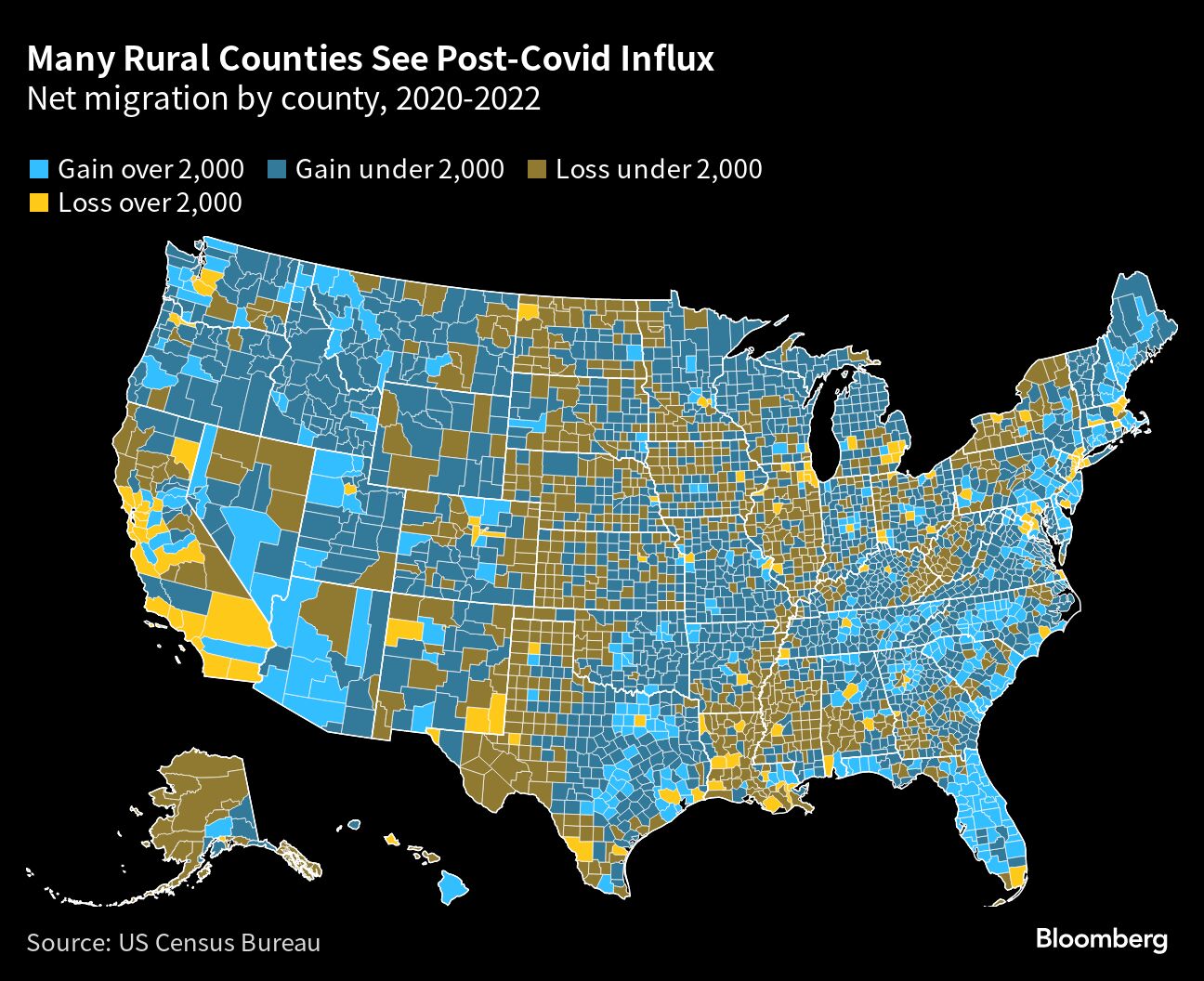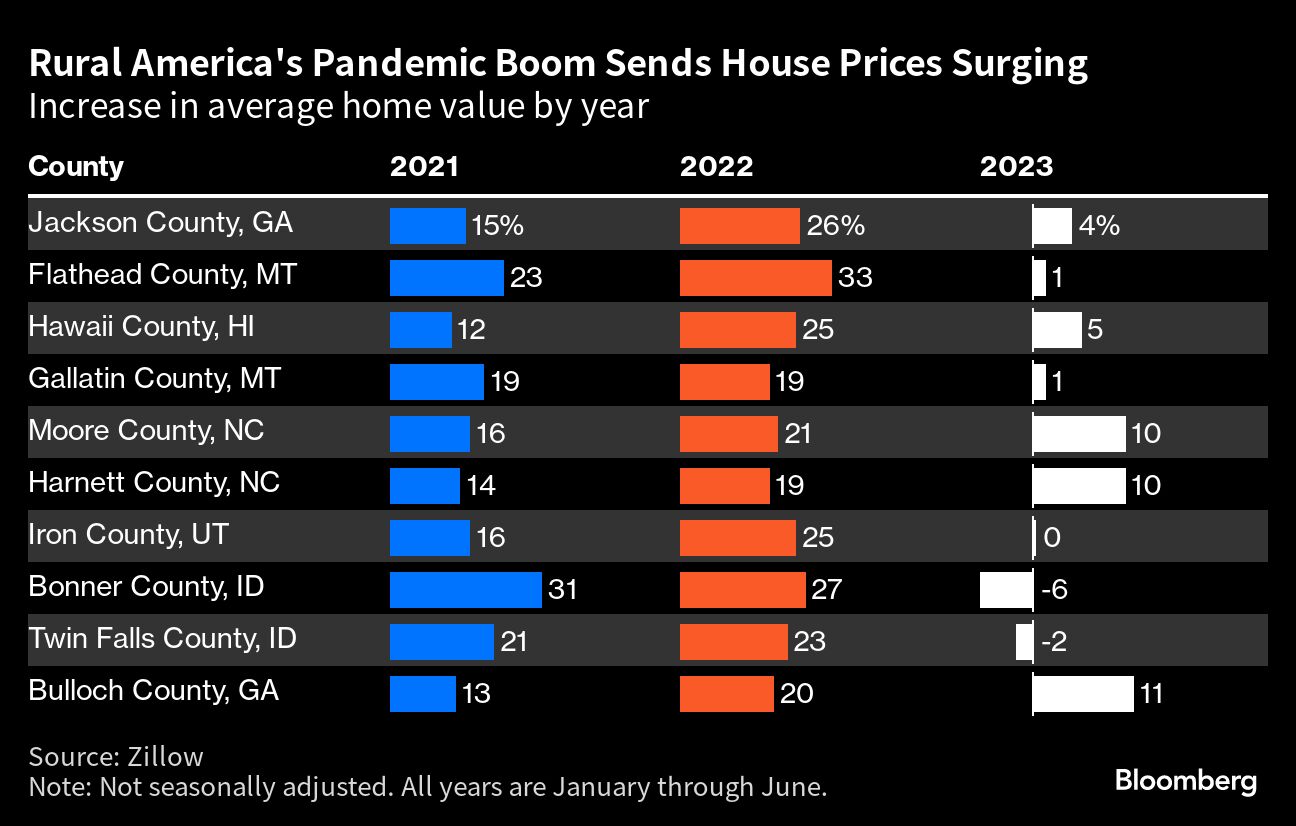Rural America is booming, but the population growth that’s boosting local economies is also putting a strain on everything from schools to housing and roads.
The influx — which started during the pandemic — has continued even as Covid restrictions have lifted. The latest government data released just last month points to a second year of increases in 2022 after years of declines.

The trend is sparking resentment as house prices in the top 10 rural counties that have seen the biggest population increases surging more than 40% over the past three years. Schools are overloaded and the shift is even impacting farmland prices.
“There’s a lot of resentment,” said Maggie Doherty, a writer and columnist who lives in Flathead County, Montana. “There’s bumper stickers that say ‘Montana’s full’ or ‘Don’t California my Montana.’”
The number of people living in non-metro areas outgrew the urban population for the first time in three decades in 2021, and the rural population expanded again last year. But growth wasn’t evenly distributed, with the top 10 counties with the largest population gains growing by an average 5%, according to Census data. That’s more than the national average of 0.4%.
Tech-savvy Californians who work from home are fleeing to cheaper states, while retirees and nature lovers are flocking to places like Montana. Many Midwesterners have now moved to the Sunbelt. And if house prices are any indication, that trend is continuing this year.

In some places, the influx of new residents is deepening political divides in an already polarized country. The migration has the potential to change voting patterns in both the places people are leaving and the ones they’re going to, adding an additional layer of unpredictability in battleground states like Georgia and North Carolina in the 2024 presidential election.
In Jackson County, Georgia, finding affordable homes is becoming harder and harder. Prices there rose 50% in the first half of 2023 from three years earlier, according to real estate firm Zillow. The county attracted hybrid workers due to its proximity to Atlanta.
“There’s been a lot of battles politically over building and where to build,” said Pete Fuller, who lives in Jackson County and heads the Democratic Party there. “There are organized groups that do not want affordable housing being built.”
Rents have also surged. In the past two years, Harnett County and Moore County in North Carolina, Gallatin County in Montana, and Iron County in Utah have all seen rent increases between 13% to 24%, Zillow data showed.
“Rent is completely through the roof,” said Wendy Cerne, who lives near Cookeville in Tennessee. “There are a lot of new people that have moved into the region and I’ve experienced that first hand.”
The rural population expanded 0.3%, or 241,300 people, in the two years through mid-2022, according to Bloomberg calculations using Census data and a US Department of Agriculture methodology. Some of the fastest-growing rural counties have had more deaths than births over the past two years, so the growth is coming entirely from new residents.
The 10 counties that saw the biggest expansion tended to be near a big city. Their broadband coverage was also 94%, much higher than the average 79% for non-metro areas, according to data from the Federal Communications Commission.
It’s not just home prices surging in rural areas. Farmland prices — already at a record due to higher commodity costs and people buying plots as a hedge against inflation — also gained.
“Anything that helps broaden and deepen what I would call the opportunity set for off-farm income is good for producers, which is a good underpinning for land prices,” said Tom Halverson, chief executive officer of CoBank ACB, a large lender to rural America.
“The states in the South and East have been some of the biggest beneficiaries of this population movement,” he said. “They also are the parts of the agricultural production complex in this country that that are most reliant on off-farm income. So there’s an interesting correlation dynamic there.”
Newcomers are also bringing economic benefits for rural America. Moore County, North Carolina’s golf courses and healthcare facilities are the main reasons for its population growth, especially when it comes to retirees, said Natalie Hawkins, who spearheads her area’s efforts to bring investment and jobs.
Sandpoint in Bonner County, Idaho, is another growing area that lured Californians with its golf and ski resorts.
“Retiring in California is near impossible,” said Bob Ficken, who moved from San Franciso’s Bay Area to Sandpoint just before retiring as a human resource manager. “The state ends up taking between 25% and 30% of everything you make.”
Still, the arrival of new residents presents a dilemma for local officials, who prize the economic benefits they bring but also have to contend with poor infrastructure to sustain the growth. Locals complain about poor traffic infrastructure, noise, overloaded schools and even homelessness.
“Especially in cities like Whitefish, which is now becoming almost a luxury resort center, they’re having a lot of disagreements on what type of house should be built,” says Doherty, the author from Montana. “A lot of affordable housing advocates are wanting high density units, and others are pushing back against that.”
In Jackson County, Fuller says the influx is stretching infrastructure.
“You see huge issues with infrastructure as well with roads, roads that were not meant to handle truck traffic a lot of times are breaking down,” he said. “There’s been two new high schools built here in the last couple years just to accommodate growth.”
--With assistance from Michael Hirtzer and Dominic Carey.
This article was provided by Bloomberg News.








